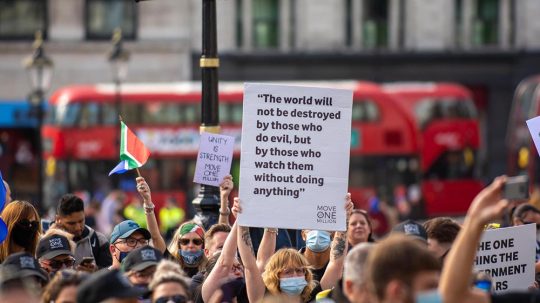
[Voiceover]: The world has been in the grips of the COVID-19 pandemic for well over a year, and while coronavirus symptoms pass quickly for some, an increasing number of people are living with long-term effects and developing a range of chronic conditions and disabilities.
‘Long COVID’ is the patient-coined term used to describe the development of multi-system chronic conditions that may continue or develop in various systems after initial infection. The National Institute for Health and Care Excellence defines ‘Post-Covid syndrome’ as symptoms lasting beyond 12 weeks. Some people have been sick for over 20 months.
Long COVID is an umbrella term used to describe patients with a diverse range of symptoms, experiences and care opportunities. This includes people with post-ICU syndrome, hospitalized or non-hospitalized patients, people with visible organ damage, people with multi-system, long-term symptoms that don’t always show up on tests, and people with initially mild or asymptomatic infections who develop long-term symptoms weeks or months later. These symptoms can include fatigue, breathlessness, heart problems and more.
For example: post exertional malaise (PEM), autonomic nervous system dysfunction, mast cell dysfunction, exercise intolerance, tissue hypoxia, tinnitus, neuralgias, liver failure, muscle pain, tremors, inflammation of the heart (myocarditis), blood clotting and others.
In June 2021, a study revealed that around 2 million people in the UK may have had Long COVID.* We’re now 18 months past the first wave and many people with Long COVID are chronically sick.
*Source: REACT-2 Program at Imperial College London
The long-term nature of these symptoms has drastic implications for people’s human rights, with marginalised communities most affected, including women, ethnic minority groups, new migrants and people affected by poverty.
In a survey conducted by the TUC with over 3,500 respondents, more than half of the respondents suffering with Long COVID had experienced some form of discrimination at work.
Almost 80% of people who reported having Long COVID in the TUC’s survey were key workers who faced much higher exposure to the virus while keeping the country running throughout the pandemic.
Many key workers in healthcare and education reported a lack of adequate personal protective equipment (PPE), social distancing and ventilation in their workplaces.
This suggests that Long COVID is already an occupational disease – with healthcare workers, teachers and other essential workers being the most affected.
As can be seen from the survey, many people who caught the disease as a result of their work are now facing critical and negative responses to their now chronic conditions. This could be discriminatory.
1 in 8 of these people had their employer questioning if they even had Long COVID at all.
For around 1 in 6 respondents, the amount of sick leave they had taken had triggered absence management or HR processes.
And 1 in 20 people said they had actually been forced out of their jobs because they had Long COVID.
Under the Equality Act 2010, your employer has a duty to make ‘reasonable adjustments’ in your job to help accommodate ongoing illness. This can include adjusting your workload, allowing you to change your working environment or having regular reviews to see how you are coping.
However, to qualify for these protections, you must have been experiencing substantial and long-term impact on your ability to perform day-to-day tasks for 12 months or more.
The Office for National Statistics reported in August that an estimated 34,000 young people under 16 are living with ongoing symptoms.
The advocacy and support group Long COVID Kids has claimed that some schools are calling social services to investigate children who have missed days due to Long COVID.
And, speaking to the Guardian, one girl said her attendance had dropped to 30% last year due to her symptoms, several of which were impacting her ability to keep up with her class ahead of her GCSE exams.
The right to education is supposed to be protected by the UK’s Human Rights Act (Protocol 1, Article 2).
Some Long COVID sufferers are having to wait months for any treatment, or worse, having their complaints of symptoms ignored or downplayed by their GPs, and are often unable to access relevant support systems. In Scotland, for example, they are yet to establish Long COVID clinics like those in the other three countries in the UK.
Sufferers of diseases like ME/CFS (Myalgic Encephalomyelitis / Chronic Fatigue Syndrome)
are all too familiar with such dismissive attitudes.
The National Institute for Health and Care Excellence was expected to release new recommendations for treating people with ME/CFS this year but has contentiously delayed publication.
Many anticipate that an update to these guidelines would dramatically increase the quality of treatment for those with ME/CFS and Long COVID, due to the similarities between the two conditions.
It’s clear that a lot still needs to be understood about Long COVID and how we can best support the people affected by it, not least in the workplace.
The right to health is internationally recognised as a fundamental human right. It is included in the 1946 Constitution of the World Health Organisation and in the 1966 International Covenant on Economic, Social and Cultural Rights.
We are at a crucial point for Long COVID - both in terms of the way we look after the people living with it and how we try and reduce the number of new cases. Surveys like the TUC’s can help us develop best practice. We need a shared approach to the human right to healthcare, based on collaboration between employers, educators and people with lived experience who need to be included in every aspect of consultation.



